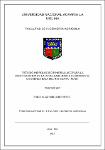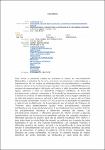Mostrar el registro sencillo del ítem
Estudio hidrológico para la identificación de la vulnerabilidad a desbordes de la cuenca baja del río Coata-Puno
| dc.contributor.advisor | Fano Miranda, Gonzalo Ramces | |
| dc.contributor.author | Lobo Reyes, Erick Vladimir | |
| dc.date.accessioned | 2018-06-11T17:28:50Z | |
| dc.date.available | 2018-06-11T17:28:50Z | |
| dc.date.issued | 2017 | |
| dc.identifier.other | P10.L63-T BAN UNALM | |
| dc.identifier.uri | https://hdl.handle.net/20.500.12996/3366 | |
| dc.description | Universidad Nacional Agraria La Molina. Facultad de Ingeniería Agrícola. Departamento Académico de Recursos Hídricos | es_PE |
| dc.description.abstract | Para iniciar el presente trabajo se realizará el acopio de documentación bibliográfica y estudios de la zona, ubicación de estaciones meteorológicas e hidrométricas, de los cuales se solicitará datos de precipitaciones y caudales máximos diarios a las instituciones pertinentes como son el SENAMHI (servicio nacional de meteorología e hidrología del Perú) y el ANA (autoridad nacional del agua), adicional a esto se obtendrán imágenes satelitales. Al tener las precipitaciones máximas mensuales a 24 horas de las estaciones se procederá a realizar un análisis de datos dudosos, por otro lado, con la imagen satelital que se obtendrá anteriormente se realizará la delimitación de la cuenca del rio Coata con la ayuda del software ArGis 10.2. Con la cuenca ya delimitada se procederá a determinará la distribución de la precipitación por el método de Polígono de Thiessen, para posteriormente ajustar estas precipitaciones máximas distribuidas a una ecuación de tendencia, lo que finalmente nos permitirá obtener las precipitaciones máximas a diferentes periodos de retorno. Las precipitaciones máximas a diferentes periodos de retorno sumado a algunas características de la cuenca nos permitirán calcular los caudales máximos a diferentes periodos de retorno, para ello se utilizará el software HEC HMS 5.1, para determinar la confiabilidad del modelo se calibrará con la ayuda de datos registrados in situ en una estación hidrométrica. Los caudales máximos a diferentes periodos de retorno, sumado a la topográfica de la zona permitirá simular el comportamiento del cauce del río, que permitirá identificar las áreas que se encuentran en peligro al desborde del rio Coata. Finalmente, para identifica las zonas vulnerables. Al concluir el presente trabajo se espera identificar las zonas afectadas por desbordes ya sean áreas de cultivo, población, infraestructura, etc. que permita posteriormente generar planes de control u obras con el fin de reducir la vulnerabilidad frente a este peligro. | es_PE |
| dc.description.abstract | To start this work collecting bibliographic documentation and studies of the area, location of meteorological and hydrometric stations, of which rainfall data and maximum daily flows will be asked to relevant institutions such as the SENAMHI (national meteorology and hydrology service of Peru) and the ANA (national water authority), in addition to this, satellite images will be obtained. Having monthly maximum rainfall within 24 hours of the stations will proceed to an analysis of questionable data, on the other hand, the satellite image to be obtained before the delimitation of the river basin Coata be carried out with the help of the software Arc Gis 10.2. With the basin delimited will proceed to determine the distribution of precipitation by the method of Polygon Thiessen later adjust these maximum precipitations distributed to a trend equation, eventually allow us to obtain maximum precipitation to different return periods. The maximum rainfall at different periods coupled with some features of the basin return will allow us to calculate maximum flows at different return periods, for which the HEC HMS 5.1 software will be used to determine the reliability of the model was calibrated with the help of data registered in situ in a gauging station. The peaks at different return periods, combined with the topographic area will allow simulate the behavior of the riverbed, which will help identify areas that are at risk Coata overflowing river flows. Finally, to identify vulnerable areas. At the conclusion of this study is expected to identify areas affected by overflows whether growing areas, population, infrastructure, etc. allowing subsequently generate control plans or works in order to reduce vulnerability to this danger. | en_US |
| dc.description.uri | Tesis | es_PE |
| dc.format | application/pdf | en_US |
| dc.language.iso | spa | es_PE |
| dc.publisher | Universidad Nacional Agraria La Molina | es_PE |
| dc.rights | info:eu-repo/semantics/openAccess | en_US |
| dc.rights.uri | https://creativecommons.org/licenses/by-nc-nd/4.0/ | * |
| dc.source | Universidad Nacional Agraria La Molina | es_PE |
| dc.source | Repositorio institucional - UNALM | es_PE |
| dc.subject | Cursos de agua | es_PE |
| dc.subject | Cuencas hidrográficas | es_PE |
| dc.subject | Hidrología | es_PE |
| dc.subject | Precipitación atmosférica | es_PE |
| dc.subject | Circulación del agua | es_PE |
| dc.subject | Inundación | es_PE |
| dc.subject | Control de inundaciones | es_PE |
| dc.subject | Modelos | es_PE |
| dc.subject | Métodos estadísticos | es_PE |
| dc.subject | Evaluación | es_PE |
| dc.subject | Perú | es_PE |
| dc.subject | Desbordes | es_PE |
| dc.subject | Río Cata | es_PE |
| dc.subject | Puno (dpto) | es_PE |
| dc.title | Estudio hidrológico para la identificación de la vulnerabilidad a desbordes de la cuenca baja del río Coata-Puno | es_PE |
| dc.type | info:eu-repo/semantics/bachelorThesis | en_US |
| thesis.degree.discipline | Recursos Hídricos | es_PE |
| thesis.degree.grantor | Universidad Nacional Agraria La Molina. Facultad de Ingeniería Agrícola | es_PE |
| thesis.degree.name | Ingeniero Agrícola | es_PE |
| thesis.degree.level | Título Profesional | es_PE |
| dc.subject.ocde | https://purl.org/pe-repo/ocde/ford#1.05.11 | es_PE |
Ficheros en el ítem
Este ítem aparece en la(s) siguiente(s) colección(ones)
-
IAG-RH Tesis [307]




